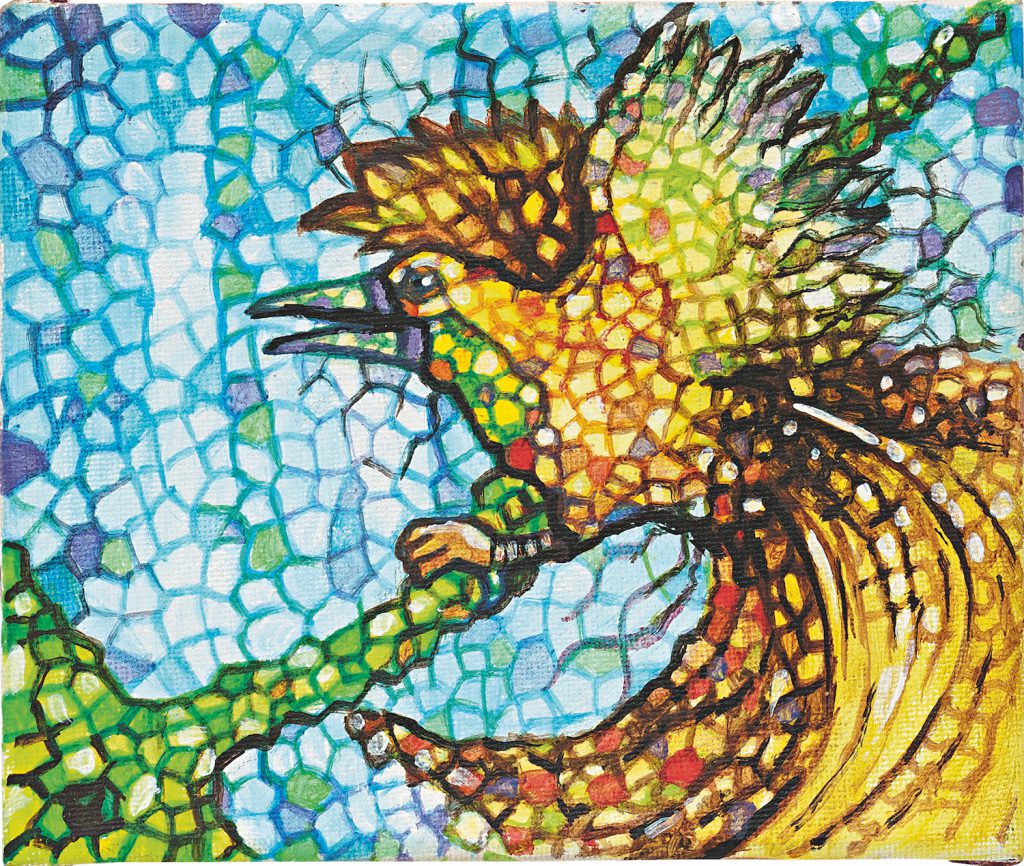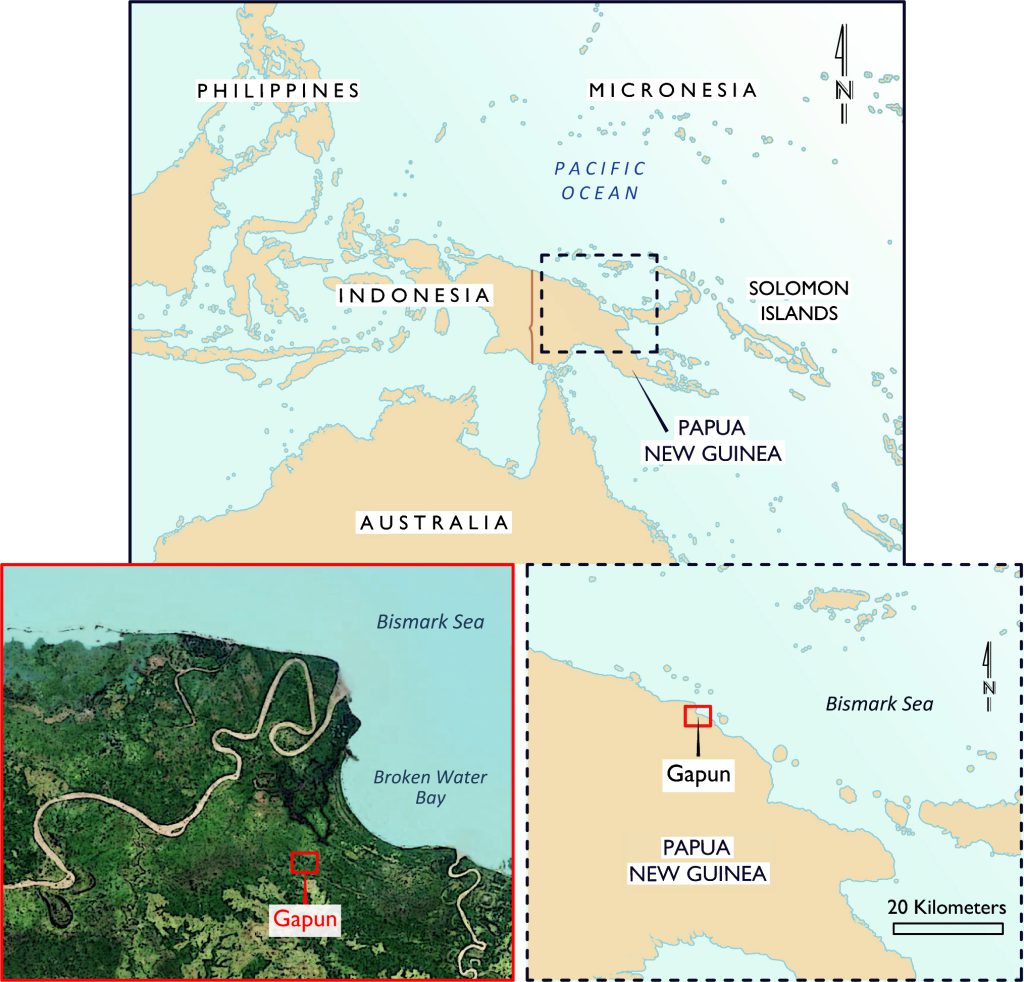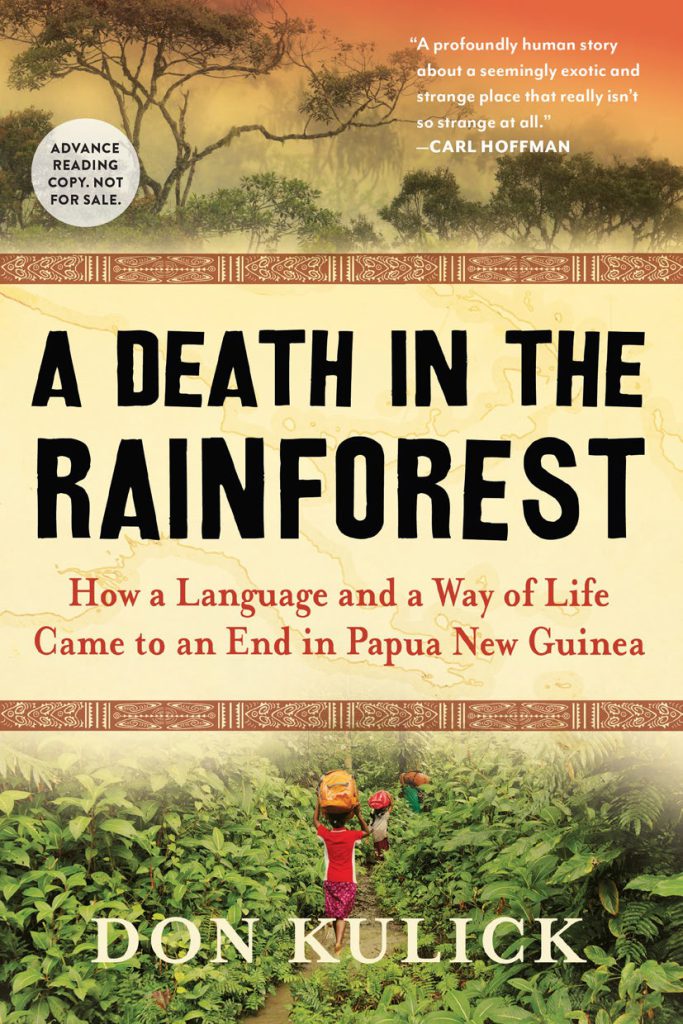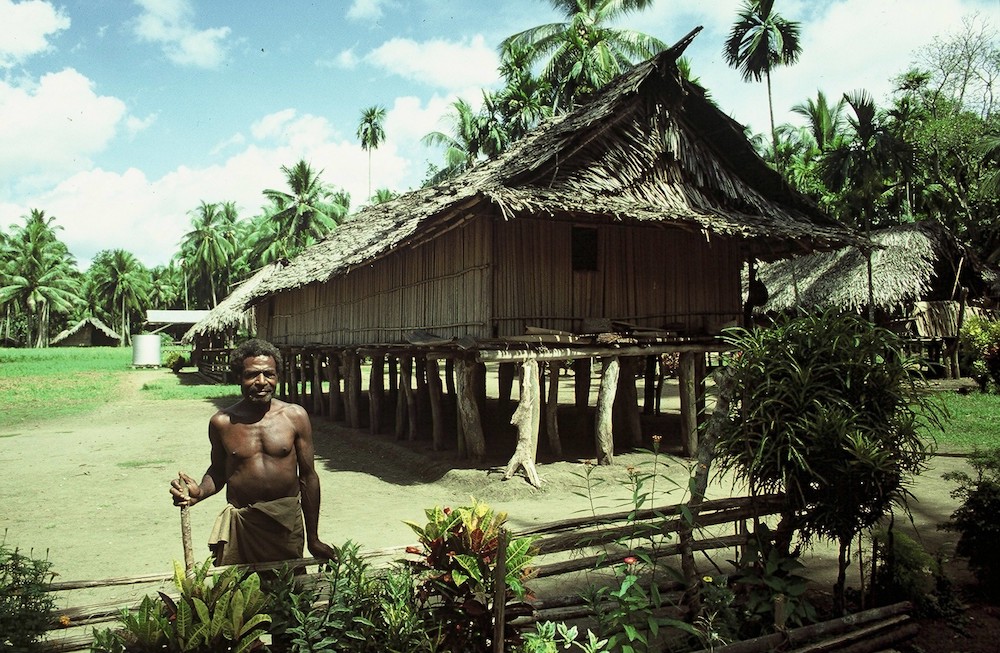What’s Left Unsaid When a Language Dies

A Death in the Rainforest: How a Language and a Way of Life Came to an End in Papua New Guinea by Don Kulick. Algonquin Books, 2019.
In the remote village of Gapun, nested deep in the rainforest of Papua New Guinea, a unique and ancient language is dying. Spoken by fewer than 50 individuals, Tayap will likely disappear within the next half-century. But how exactly does a language die? And why doesn’t the death of this language matter to the Gapuners who speak it? These questions lie at the heart of anthropologist Don Kulick’s latest book.
A Death in the Rainforest does not focus solely on the death of Tayap. The book goes beyond salvage linguistics—oftentimes paternalistic attempts by scholars to “rescue” endangered languages. Part ethnography, part memoir, the book spans Kulick’s more than 30-year engagement with the community of around 200 people: how he came to Gapun in East Sepik province, learned to be part of village life, and eventually let his ties go.
Readers come to understand that the slow death of Gapuners’ culture and way of life began long before that of their language. This death started with the arrival of White colonizers and was perpetuated by Christian missionaries who visited the village after WWII. Over the course of the 20th century, men in Gapun started leaving the village to become contract laborers, plantation agriculture largely undermined traditional subsistence practices, and foreign companies exploited native forests for timber.
By the mid-1980s, when Kulick first visited the village, Papua New Guinea had gained independence from Australian colonial rule. Gapuners had by then come to desire the knowledge and material goods associated with the “modern” world—a world made more accessible through the rejection of Tayap and the adoption of Tok Pisin, the most widely spoken language in Papua New Guinea. Over time, Kulick witnesses how unemployed and disaffected young men start engaging in banditry, furthering the breakdown of village social ties that started with colonization.
Threaded through this narrative of a village in transition are multiple, overlapping endings—the end of an ancient language, a traditional way of life, and an anthropologist’s encounter with people who at first seem radically different from himself.
Over the course of the book, the stark cultural differences between Kulick and the Gapuners fall away to ultimately reveal human commonality and connection in an unequal world. Readers learn that the death of the Tayap language also means the loss of place-specific ecological knowledge. This loss has profound implications not only for Gapuners but also for the future of all humans whose well-being is inextricably bound to the continuance of natural ecosystems.
What makes A Death in the Rainforest compelling to read? For one thing, Kulick abandons the pretense of mastery so often assumed of scholarly writing. Despite studying Tayap for many months on and off over the course of three decades, Kulick admits that he never learned to speak the language. He struggles to distinguish one type of tree from another in the forest. He unfailingly returns to the village covered with mud from falling off slippery bridges.
Kulick also complains of the discomforts that shaped his time in Gapun—the mosquitos swarming the forest, the venomous snakes lurking beneath the mud, and the subterfuges required to evade the feces-ridden maggot stew generously offered by his companions.
By stripping fieldwork of its romantic veneer, Kulick sets out to candidly answer the burning yet unspoken question raised by many a finessed ethnography: What is it really like “out there”?
Humor acts in Kulick’s book as an antidote to the despair that arises in the face of cultural and environmental destruction brought on by the forces of global capitalism and the legacies of colonialism. For all the harrowing loss and violence the author recounts—the brutal murder of a villager by gun-wielding thieves from a neighboring village, the growing poverty plaguing the community, and his eventual flight in response to increasing violence—A Death in the Rainforest is also tremendously funny.
Comic cross-cultural comparisons help readers relate to the story’s lively cast of characters—and allow Kulick to get away with statements that could otherwise easily be deemed offensive. For instance, he compares sago jelly, a prized food among Gapuners, to slimy sputum but then juxtaposes that description with one of surströmming (sour herring), a specialty in his home country of Sweden that smells and tastes like feces.
In between these at times jaw-dropping descriptions, Kulick delves into the paradoxical nature and complex power dynamics of good anthropological fieldwork: the unpleasant necessity of overstaying one’s welcome and negotiating the demands of those who (more or less willingly) welcome strange anthropologists into their communities.
Kulick self-identifies as a “white American/European middle-class male professor” writing about “largely moneyless … black villagers who live in a backwater swamp in a faraway Oceanic country.” Gapuners, meanwhile, identify Kulick as the ghost of a dead villager returned to lead his kin down the “‘road’ to change.” The villagers hope Kulick will help them acquire white skin—a deeply desired bodily attribute they associate with power, wealth, and knowledge. This brings villagers to ask Kulick for things that will help quell what they call their “little worries”—money, cigarette lighters, a letter to pass on to a dead relative in heaven.
These repeated, and to Kulick at times tedious, demands point to something that both Gapuners and Kulick can agree on: “white people have too much stuff”—and therefore a responsibility to share with those who pay the price for progress. Responsibility, and the failure to live up to it, thus constitutes a recurring motif throughout Kulick’s account: How do the privileged (in this case, White people from Western countries) give back to those whose worlds are dying because of them?
Without ignoring these injustices, Kulick makes a point to emphasize the wondrous resiliency of Gapuners. Despite over a century of colonization, missionization, and capitalist incursion, Gapuners are still a “proud and irascible” people. They may no longer speak Tayap, but they continue to walk the forest to process sago, teach their children independence, and hope for a better future. With their villages razed, their forests targeted for carbon markets, and their communities plagued by unprecedented violence, Kulick expresses wonder that Gapuners “continue to live at all—and to thrive.”
The stark cultural differences between Kulick and the Gapuners fall away to reveal human commonality and connection in an unequal world.
It is against this backdrop that the death of Tayap becomes less traumatic to Gapuners than one might expect. Gapuners, interested less in the continuance of tradition than in the arrival of change, themselves encourage the use of Tok Pisin.
One anecdote that illustrates this point revolves around a visit to the afterworld recounted by Kak (a pseudonym), a young male Gapuner. During this event, Kak leaves his body and travels to hell. Along the way, he encounters vast cities, deceased kin with white skin, and mountains of discarded Converse shoes uncannily like those worn by Kulick himself. Eventually, Kak arrives in hell, where Black people sweep toilets while waiting for Jesus.
Hell, Kak concludes, isn’t all fire and destruction. Far from a distant and alien place, hell manifests in the toils of everyday life and in the Blackness of Gapuners’ own skin. Hell is the place where Gapuners are now.
Kulick’s A Death in the Rainforest is a book about violence, power, and position. As an account of endings, it also raises important questions about anthropology at a time when the social sciences are facing institutional death. Who, after all, is anthropology for? Why does that question matter, and in the end, who does anthropology serve?
Kulick identifies the capacity to unearth the familiar in the strange as anthropology’s greatest strength—and its greatest responsibility. As an anthropologist with power and privilege myself, I agree with Kulick that we must remain accountable to our interlocutors through the way we represent their viewpoints—even as those viewpoints might confound, trouble, or challenge our own.
Kulick conveys to his readers, most of whom are presumably Westerners, that for all their radical “otherness,” Gapuners are, at the end of the day, not that different from themselves. Gapuners laugh, cry, and swear for many of the same reasons—unfaithful spouses, lazy children, and untimely deaths.
Anthropologists must journey into countless labyrinthine forests and across perilous footbridges. Like Kulick, we will often return home soaking wet, covered in mud, and worn out by fear and frustration. But we must keep traveling these forests and footbridges. We must keep asking these questions—of ourselves and of those who travel with us. The same goes for anyone navigating encounters with human difference.
Along the way, we might heed the call of Kulick’s Tayap instructor to prioritize “little talk” over “big talk.” “Big talk” refers to formal linguistic conventions; it is the disembodied grammar of languages. “Little talk,” on the other hand, is full of guts, nerves, and spit. It takes the form of everyday stories, disputes, and dilemmas.
The distinction exposes the broader power dynamics that render some kinds of talk “small” and others “big” in the first instance. And it reveals “little talk” to be the very place where big ideas—about difference, hope, and loss—come to life.
Ultimately, for Kulick, to engage with difference is generative because it is risky. But not engaging with difference, the book insists, is the biggest risk of all. Ignoring differences obscures the rich plurality of human ways of being and thinking. It also effaces the structural violence that unevenly connects us all in a world where “every nook and cranny of humanity,” as Kulick writes, “has been brutally fondled and painfully probed by the sticky fingers of colonialism and capitalist exploitation.”
Seen from this perspective, the death of a “little” New Guinean language is less removed from Westerners’ lives than it might seem. Tayap constitutes a precious yet fragile trove of knowledge about nature, climatic cycles, and ecological relationships. The loss of this language comes at our collective peril.



































